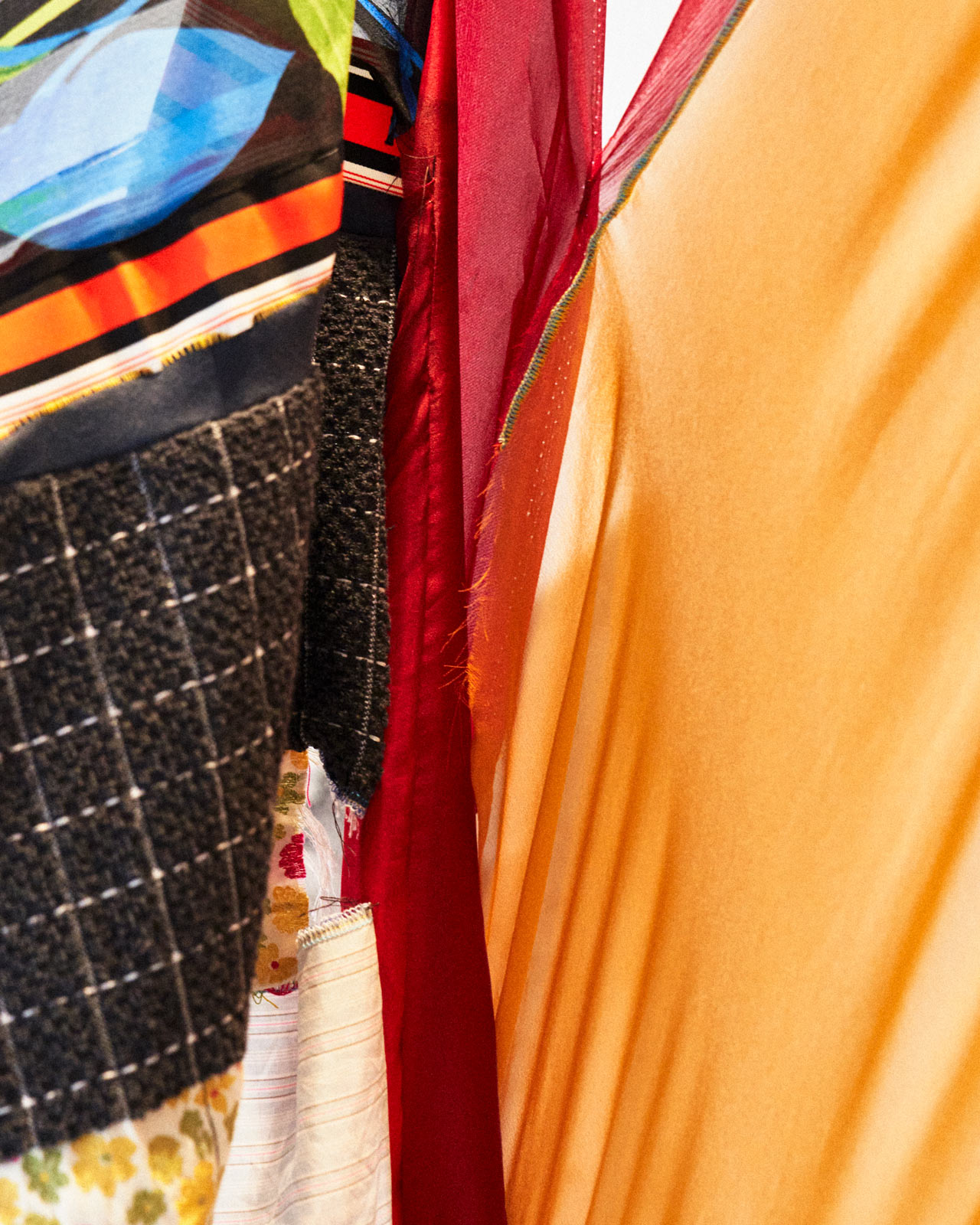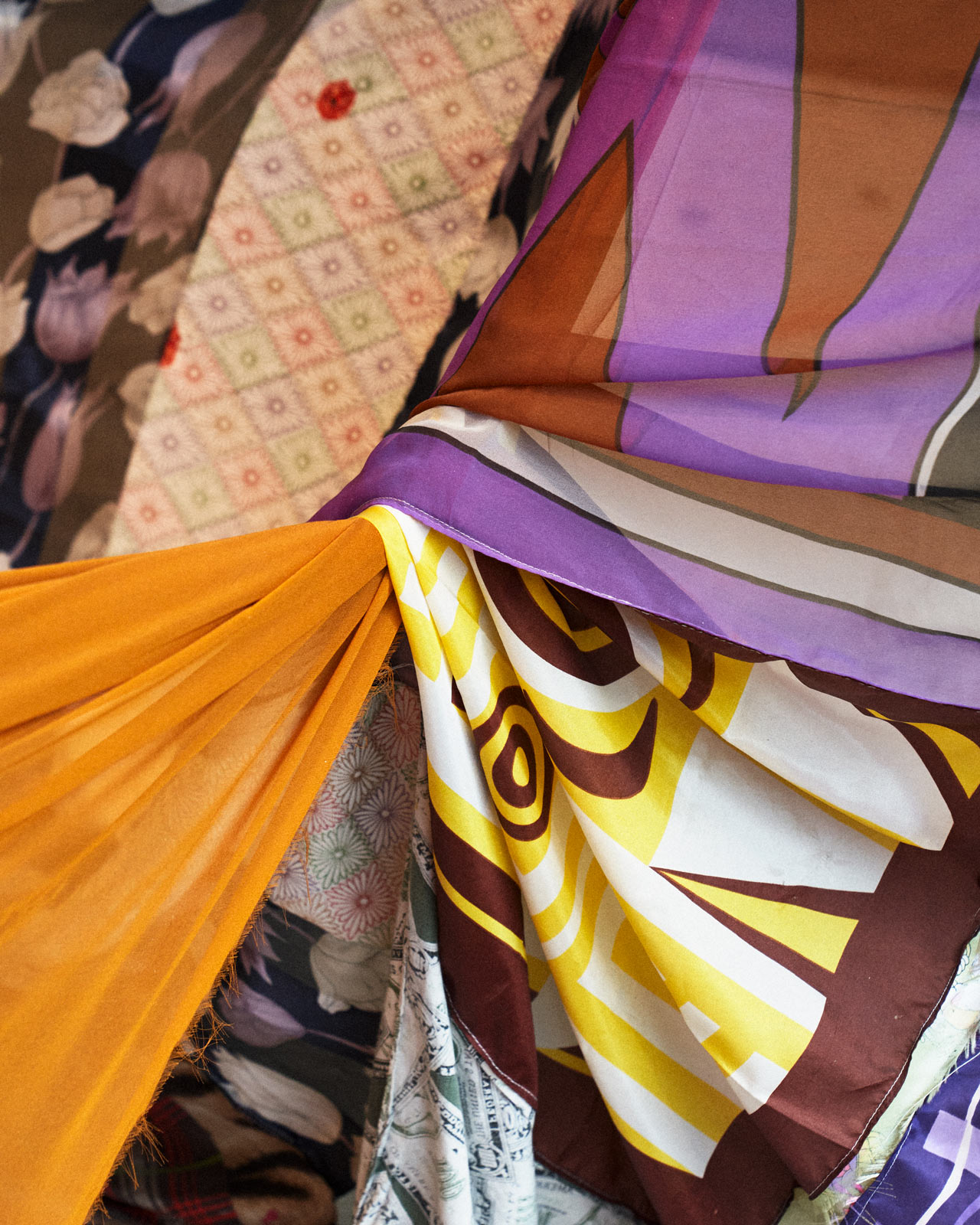For Document’s Winter 2021/Resort 2022 issue, the artist speaks on how he’s translating his South Bronx informed textile practice to the context of the Italian everyday
Eric N. Mack and I have been talking about art since 2013. We first met when he was an artist-in-residence at the Studio Museum in Harlem. The residency is the crown jewel of the museum, along with the institution’s exhibition program, providing a platform for Black artists across the diaspora and claiming a long roster of illustrious alumni. The Studio, to be sure, is an incubator for creatives across disciplines, both established and emerging, and I was there as a curatorial fellow at the time of Mack’s residency. On occasion, we would have in-depth conversations about our references, influences, and points of view, with a heavy emphasis on fashion. Since then, Mack has collaborated with designers including Grace Wales Bonner and Duro Olowu.
I have come to realize that the core of Mack’s practice is his understanding of how textiles are imbued with meaning because of how our bodies inhabit and use them both in life and in ritual. He is highly fluent in this language—the legibility of textiles, the haptic. When he discusses ideas, his speech is reminiscent of how architects describe, with a kind of poetry, the relationship between the body and space.
I spoke with him this fall during yet another prestigious residency. Mack is currently at the American Academy in Rome. He was awarded the Rome Prize, a project-based residency, in part for his proposal In austerity, the work will be stripped from its support and worn as a sarong (2019). The title not only points to the lyricism evident in his paintings but also to the ideology which addresses the same collapse of form and function found in architecture. The proposal mentions specific Italian cultural movements as a focal point of his research, as well as Christo as an influence. Christo, an artist known for large-scale, site-specific installations, often used fabric to activate architectural landmarks or landscapes. For example, his final work, L’Arc de Triomphe, Wrapped (2021), unveiled posthumously, saw the iconic monument in Paris completely draped with gauzy, transparent ivory fabric.
Christo, Mack posits, subverted conventional painting by using fabric as the medium and architecture as the support. Another example is Mack’s own work. Halter (2019) was created as an installation for Desert X, a biennial staged in the Coachella Valley. Halter was a sewn collage, made with a Missoni knit textile sourced from the brand’s archive, stretched across an abandoned building structure in the desert. The work was “inspired by the suspension of a halter top [to] identify the relation to a body and determine the seams as connected to garment construction,” Mack wrote. During one recent conversation, Mack suggested that dress as a form of personal expression could also be seen as collage. This proposition reflects much about his thoughts around abstraction and his own painting practice.
We spoke about his plans for Rome, recently joining Paula Cooper Gallery, and his traveling solo exhibition, Eric N. Mack: Lemme walk across the room.
Monique Long: My first question is about Rome and your residency at the academy. First of all, congratulations—it’s really huge. I’m really fascinated by Rome and the city as a site of imperialism. There’s a long history that goes back to antiquity about how [the Romans] considered textiles a way to communicate relationships to hierarchy, citizenship, and nationalism. I did read your proposal In austerity, the work will be stripped from its support and worn as a sarong, and [you discuss] this relationship between architecture and the body, and those two things being interchangeable. I know that was probably three questions in one, but I just want to know what you hope to achieve in Rome, based on your proposal.
Eric N. Mack: In general—outside the proposal—I wanted to be able to perceive the everyday kind of Roman attitude and to think about where that has come from. There are definitely communications of power that I see every day, that we all see every day, in terms of how architecture shows up in the buildings, the monuments, the statues—[calling] upon ancient knowledge, ancient power, and sophistication, in some cases. It’s extremely heavy lifting, to kind of deal with all of it at once. But I’m going off of my own perceptions of those things—the way that I think about power, and expression, and those things being communicated through the ways one dresses oneself.
There’s a lot of oscillation between this understanding of what’s happening in the studio and this intense immersion, which I’m kind of translating—concepts that would normally be in my studio in the South Bronx [but are now] here in Rome, the Italian everyday. The way that I’ve started has been kind of about a recognizable process. I’m locating fabric shops as I’m learning Italian, [becoming] able to communicate how many yards I need, or how much something costs, and whether that makes sense to me, or whether I need to barter. [I’m] going to flea markets, outdoor market kind of places, that really deal specifically in the rag trade. There’s one in particular that I go to on Sunday mornings, it’s called Porta Portese, and I find it really interesting. I’ve talked to friends that I’ve met here in Rome, and they say that you have to wake up super early, like, at 7:30 a.m., to beat the crowds and see if you can find something, some kind of gem, in these piles and piles of old garments, used objects, vintage ceramics, bootleg electronics. It’s a real intense thing, just the amount of material that’s out there in these marketplaces.
Monique: You speak a lot about the sort of inherent qualities of certain textiles. Getting back to your process now, of looking and searching in all these different contexts, are you still in the process of understanding how those meanings change? Maybe you can identify some of the differences between [sourcing textiles] here, in the United States, and working in Italy.
Eric: I feel like I’m still exploring and locating. There’s a group of fabrics that I found most recently that are silk scarves, and some that have printed text, that come from maybe some sort of corporate promotion. And then there are a few that are dyed with stripes in this very particular, almost marbleized kind of way. The fabric that I’ve been interested in is kind of a transparent textile—something very thin. In general, I locate a lot of what I’m looking for, [with respect to the] textile world, as coming from the space of painting discourse. So [I’m thinking] about color and radiance, transparency in relationship to a kind of luminousness, and these materials as a kind of vehicle for light.
Monique: That really brings me to the next question that I had about when a viewer is experiencing your work. I think experiencing is a better word than looking, although both are happening simultaneously. What are the formal qualities that connect your work to painting? Can you just unpack that for a viewer? How are they similar, and how are they different?
Eric: I think a lot about painting as a kind of technology. Really, the work comes from a desire for the painting technology to be able to update itself, and that showing up as a kind of physical move away from the wall.
The things that I find interesting about painting have to do with the structure of a canvas. Is it wood? Is it aluminum? It allows itself to be rigid, and those structures are called stretcher bars for a reason. The fabric itself is stretched across a wooden support structure. So one of the things I wanted to see—in an experiment—[was] if the painting can exist without the traditional supports, and maybe those things can extend into physical space, maybe have a more specific use. How does that move into space relate to the body—the body being a site for perception and understanding—or talk about the body? So it really is about the painting engaging a kind of intimacy, in a way. If [the painting had] some proximity to the viewer that would be more of an active engagement.
Monique: Yes. Yes.
Eric: I think about visual poetics: how form can be a contortion, how form can shift and wrap itself. Those things are very much a part of everyday observations. Walking around my neighborhood, there are different moments I recognize. There’s a building under construction, there’s a tarp that’s lining a scaffolding. That relationship, for me, is very close to a painting relationship in a traditional sense, except the surface itself is something you see through. It doesn’t diminish [the painting]; the painting ends up being a layer that you look past, in a way. There are a lot of things in our everyday that are structured to not be noticeable that I think are things that speak about life.
“There are a lot of things in our everyday that are structured to not be noticeable that I think are things that speak about life.”
Monique: I’ve been thinking about your work for so long, especially in relation to fashion, but I’ve really been neglecting the aspect of architecture. Especially what you just described here—an architect can make a plan, right? And they can imagine all the ways to build that structure. But what can’t be predicted is how it will function for the person, or people, that the structure is for, and how they will use it. I heard you say something about how you consider memory an aspect of your practice: the viewer’s memory, how they assign meaning to a textile that you might include in one of your paintings. You can’t really predict [that]—it’s a variable that can only be perceived in that space, at that time.
Eric: There are things that repeat themselves, or a form that produces a particular kind of function. I think that’s content within form. And those things are meant to communicate. Especially thinking about abstraction as a [technique] that breaks up space at times and could also unify it in other ways. I think abstraction functions in everyday space, and I’m interested in making some of those ideas tangible. So [if a] particular fabric brings up a kind of memory, that being made spatial, it functions almost like when we’re in a building and ends up being made to possibly do something different.
Monique: I wanted to talk about how much I love the title, Lemme walk across the room. It’s a title from your solo exhibition at the Brooklyn Museum in 2019, and it’s [the title of your exhibition] recently on view at NSU in Fort Lauderdale, Florida. The title is rooted in Black vernacular expressing style or personal presentation. But it’s more about how you say it—the cadence and attitude.
Eric: Lemme walk across the room was almost like a directive. I think a lot about what it’s like to experience art in a museum, and the things that go unconsidered in [terms] of what the viewer brings to an exhibition. It’s a bit like, ‘Come on, come as you are.’ A kind of universal directive. And at the same time, it prompts the viewer to surrender to what the work is and [to consider] these questions like, ‘What is the painting? What is the exhibition space? What is my physical relationship to sculpture? What does it look like for me to walk through an exhibition?’ That was achieved through the divide of the exhibition space. This piece called Seat Pleasant scaled across the room and was tethered to opposite walls, but [the] fabric had a loose weave that created a slight translucency. Within the play of the lighting, a viewer could perceive that they would be projected onto the [work] and could also perceive others within the space through this kind of gauzy cotton fabric.
Monique: Your influences seem very interdisciplinary. You’ve referenced the performative nature of 125th Street in Harlem, Lil’ Kim and the second wave of hip-hop in general, and visual artists like Helen Frankenthaler and Sam Gilliam. Are there any other visual artists or disciplines that you look to or refer to in your work?
Eric: A big part of being here, the excitement in being here, is thinking about how these amazing artists I respected for so long have addressed Rome and the [American] Academy. So some of the research that I’m doing has to do with finding documentation of these previous exhibitions and activations here at the Academy, one of them being this collaboration between Jannis Kounellis and David Hammons. Hammons is a huge hero of mine, and pretty much his whole trajectory inspires me. I think a lot about what the work means in relation to the political background of his time and how his work was perceived by people in the ’70s [who wanted] to really absorb some of its radicality.
Especially during quarantine, movies have become more and more important to me. Music videos have always been important to me, but I want to figure out how to incorporate film references in a way that doesn’t necessarily look like me making my own film. I’ve been thinking a lot about the German director [Rainer Werner] Fassbinder. There are a number of films that I’ve watched and been enthralled by that really communicated through costume, like The Bitter Tears of Petra von Kant, Beware of a Holy Whore, and In a Year of 13 Moons. They’re all very much about this particular [period in] 1970s Germany, and dealing with the post-war condition. Also, the Spanish director Pedro Almodóvar is really amazing. Especially [during quarantine], that was a way that I could kind of travel in my mind and think about all these other ways of expression, all these stories, and how they communicate simply through clothing.
Monique: I was waiting for you to say that, because [Almodóvar’s] earliest films are contemporaneous with the Paninaro, an ’80s youth movement in Milan which I read about in your project proposal. What was happening in Spain post-Franco and La Movida—there are a lot of similarities [with 1970s Germany]. And they’re happening concurrently.I hesitate to ask, but I’ve always been curious if you’ve ever thought about designing your own clothes?
Eric: Those things end up happening accidentally. Conceptually, I might find a reason to, and I definitely have. So, in one exhibition, I really wanted the wearer to be able to engage with the work like a painting—to be able to try on a painting the way you’re able to try on a shirt. But the idea is that the painting is formatted as a shirt.
Monique: I’ve wanted to try on one of your paintings, for sure. I wanted to, I’ve had a desire to. They’re very seductive.
Eric: That is definitely a vehicle of fashion, the kind of fantasy of fashion, but in terms of the garment culture, I like the idea of this object being able to leave the gallery—imagining that the owner has to figure out whether they will hang this in their closet or hang it on the wall. That’s very much up to them.
Monique: I want to end on your work Landlord (2021), which was on view [at Paula Cooper Gallery], and how it blurs the line between abstract painting and fashion display because of the context of the work. It’s being shown in a gallery but also it’s in a window which passersby can see from the street. There are all these beautiful, saturated colors. Can you talk about Landlord as an installation?
Eric: This piece started off in the studio as two separate works. There’s a triple flagpole bracket, that [allowed the fabric to] extend into the room, attached to an umbrella. Both of those ready-made structures are things that I’ve worked with before, but I think it was important to ground [the work] a bit more. With the title, I wanted there to be a grounded conversation about power, and authorship, and ownership, and paying respect. The umbrella has meaning as personal architecture and the flagpole as this almost support structure. If you think about the possibility of that—at least in my language, if my work extends from painting—then the American flag could also be a painting. The flags of many nations could end up being paintings that represent place, politics, power, imperialism, capitalism. Those structures come together in a poetic way. I’m not trying to make any kind of definitive statement, but more or less suspend a bunch of questions.
‘Landlord’ by Eric N. Mack is included in the current group exhibition ‘Stitched‘ at Paula Cooper Gallery at 524 W 26th Street through February 19.















